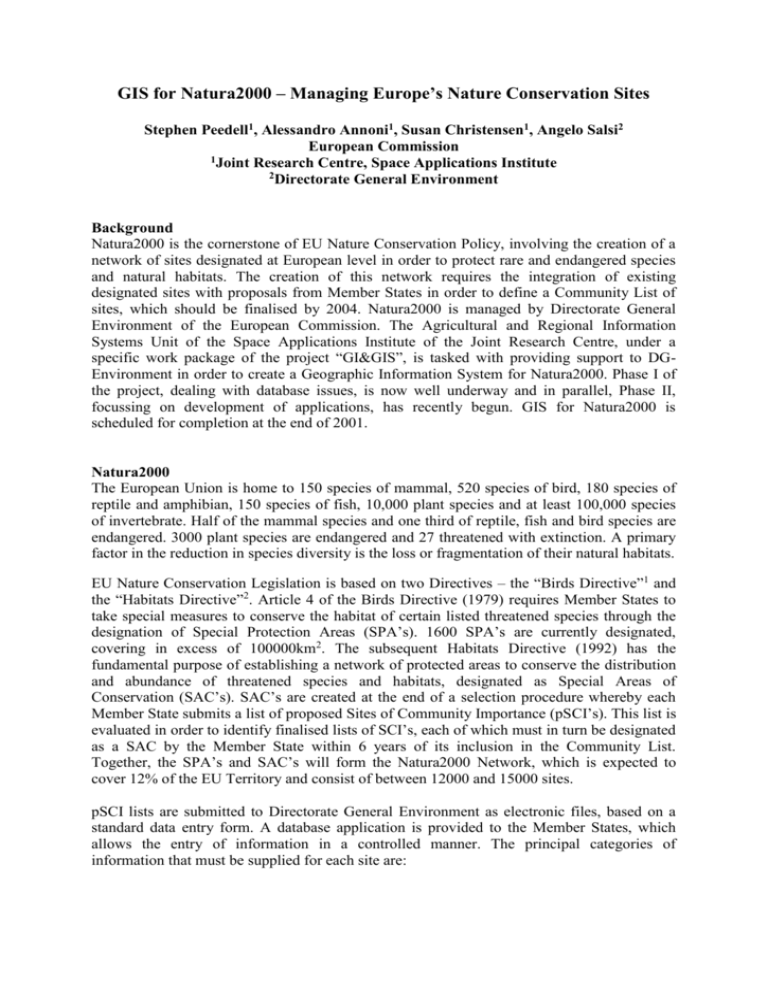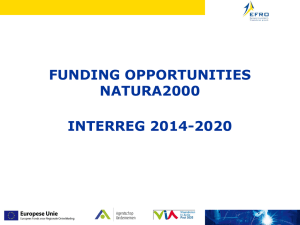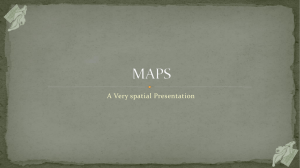Managing Europe`s Nature Conservation Sites
advertisement

GIS for Natura2000 – Managing Europe’s Nature Conservation Sites Stephen Peedell1, Alessandro Annoni1, Susan Christensen1, Angelo Salsi2 European Commission 1Joint Research Centre, Space Applications Institute 2Directorate General Environment Background Natura2000 is the cornerstone of EU Nature Conservation Policy, involving the creation of a network of sites designated at European level in order to protect rare and endangered species and natural habitats. The creation of this network requires the integration of existing designated sites with proposals from Member States in order to define a Community List of sites, which should be finalised by 2004. Natura2000 is managed by Directorate General Environment of the European Commission. The Agricultural and Regional Information Systems Unit of the Space Applications Institute of the Joint Research Centre, under a specific work package of the project “GI&GIS”, is tasked with providing support to DGEnvironment in order to create a Geographic Information System for Natura2000. Phase I of the project, dealing with database issues, is now well underway and in parallel, Phase II, focussing on development of applications, has recently begun. GIS for Natura2000 is scheduled for completion at the end of 2001. Natura2000 The European Union is home to 150 species of mammal, 520 species of bird, 180 species of reptile and amphibian, 150 species of fish, 10,000 plant species and at least 100,000 species of invertebrate. Half of the mammal species and one third of reptile, fish and bird species are endangered. 3000 plant species are endangered and 27 threatened with extinction. A primary factor in the reduction in species diversity is the loss or fragmentation of their natural habitats. EU Nature Conservation Legislation is based on two Directives – the “Birds Directive”1 and the “Habitats Directive”2. Article 4 of the Birds Directive (1979) requires Member States to take special measures to conserve the habitat of certain listed threatened species through the designation of Special Protection Areas (SPA’s). 1600 SPA’s are currently designated, covering in excess of 100000km2. The subsequent Habitats Directive (1992) has the fundamental purpose of establishing a network of protected areas to conserve the distribution and abundance of threatened species and habitats, designated as Special Areas of Conservation (SAC’s). SAC’s are created at the end of a selection procedure whereby each Member State submits a list of proposed Sites of Community Importance (pSCI’s). This list is evaluated in order to identify finalised lists of SCI’s, each of which must in turn be designated as a SAC by the Member State within 6 years of its inclusion in the Community List. Together, the SPA’s and SAC’s will form the Natura2000 Network, which is expected to cover 12% of the EU Territory and consist of between 12000 and 15000 sites. pSCI lists are submitted to Directorate General Environment as electronic files, based on a standard data entry form. A database application is provided to the Member States, which allows the entry of information in a controlled manner. The principal categories of information that must be supplied for each site are: General: Site location, dimensions, ownership, name, characteristics, vulnerability and biogeographic zone Fauna Species (Birds / Fishes / Amphibians & Reptiles / Mammals / Invertebrates): Species present, population (Resident or Breeding/Staging/Wintering), conservation status, degree of isolation, overall value of the site to that species. Flora Species: Species present, population, conservation status, degree of isolation, overall value of the site to that species Habitats: Habitat type, percentage cover, representativity, area of habitat as percentage of national total, conservation status, global assessment of the value of the site. A Spatial Database for Natura2000 In contrast to the rigorous definition of information requirements for alphanumeric data, supported by detailed specifications and a comprehensive data entry application, the requirements for provision of geographic information are less exhaustive. As a minimum, all sites must be drawn on maps of the same detail and quality as the official published topographic maps and meeting all the standards of the competent topographical institute, at a scale of 1:100,000. Thus DG Environment has a significant archive of printed topographic maps with Natura2000 sites delineated on them. Whereas the benefits of digital data provision are mentioned, this is not a mandatory requirement. In fact, in providing site data, most Member States did in fact provide digital site data. However, these data are not homogeneous, with significant differences in terms of digitising procedures, reference data, scale, format, spatial reference system, geographic projection and nomenclature. These differences are usually reflected on a national basis (where regional differences are normally solved). Thus, Natura2000 has two basic data collections – the map archive and the alphanumeric database. A priority activity is to integrate these 2 discrete systems into a single spatial database. The Natura2000 alphanumeric database contains several elements of explicit spatial information (site centroid, area), as well as implicit spatial information (relationship to NUTS administrative regions, altitude, relationship to CORINE biotopes, relationship to other Natura2000 sites etc). Often, when the digital site boundaries (polygons) are analysed, anomalies are detected between these spatial data and the alphanumeric database. For example, a site whose recorded centroid falls outside of the site polygon, or whose recorded area differs significantly from the geometric area of the polygon. We performed an initial analysis of the types of anomalies that could be detected, which led to the specification and development of an application to automatically process the sites on a country-by-country basis. This software, called “GISVAL”, has been developed in ArcView, and uses the digital site boundaries provided by Member States, the Natura2000 database and reference data (primarily from Eurostat-GISCO) in order to produce a database of the results of the validation checks. Any anomalies between the validation database and the Natura2000 database can then be used as the basis for reporting back to the Member States in order to resolve them. In designing a spatial database for Natura2000, it should be noted that digital data have no legal status, and therefore in order to use these data we will have to determine that the digital boundary does in fact correspond to that on the paper map provided by the Member State. Once this has been achieved, future paper map products can be generated electronically. The paper map archive contains a vast amount of topographic information, which is useful to DG-Environment in understanding the geographical context of a given site. Unfortunately, the results of the validation process will be simply the site polygons, without any additional reference information. Scanning of the paper maps has been discounted due to a combination of factors including cost, copyright and management issues. Harmonising digital raster sheets of all the major mapping agencies in Europe would be a major task. Basic topographic reference data, preferably in attributed vector form, will therefore have to be acquired at 1:100,000 scale for Europe, and a number of interesting initiatives are already underway in this respect. In some cases these, and other useful datasets, are available at national level in digital form, but would be difficult to obtain (due to a missing European GI data policy) and to harmonise to European level. Priority datasets are standard topographic and man-made features (transport, settlement, hydrography), Digital Elevation Models and a gazetteer. More detailed thematic data such as habitat inventories are more problematic since standard approaches are not necessarily followed. Thus the legend for a forest habitat survey in one Member State may be different from another, according to differences in methodologies and semantics. The creation of a spatial database for Natura2000 represents Phase I of the project. A contract has recently been awarded to perform the necessary cataloguing and validation tasks, based on the tools and techniques already developed. As part of a phased programme, sites will now be validated and entered into the database. GIS for Natura2000 Phase II of the project has now been initiated, focussing on applications. From the above review of spatial data related to Natura2000, Geographic Information Systems are an obvious technology for management, analysis and visualisation of Natura2000 information. We have concentrated so far on the server side of such technology, in order to integrate geometric and alphanumeric information fully within a single spatial database. Initial reviews of user requirements within DG-Environment indicate a high priority to develop simple GIS applications, which allow rapid identification of sites and the presentation of their geographical context, and the thematic information (habitats, species etc) contained in the database. This light, browsing type of application can be developed using intranet technologies. More sophisticated applications for modelling and monitoring of sites are limited by scarcity of data at European level and the priority given to administrative applications at the present time. Many of these thematic applications have in fact already been developed by individual Member States, and thus we have conducted a thorough survey of activities at Member State level, in order to identify current best practice and to avoid reinventing the wheel. We are keen to encourage collaborative work within the context of Natura2000, and throughout the application development phase we will attempt to work with administrations at regional or national level wherever appropriate. Applications developed during 2000 will be prototypes, allowing the investigation of different methodologies and technologies. We expect that as a result of this activity user requirements will evolve, becoming more analytical in nature, and during 2001 these prototypes, together with the requirements, will be translated into formal specifications for the system to be implemented. Conclusions Natura2000 has a vast scope, involving a broad group of actors, a diverse and detailed range of information, much of which is geographic. Without GIS, management and access to the Natura2000 data is problematic. For GIS to succeed, a robust, integrated spatial database is required and this has been our priority activity to date. Initial GIS applications will, by necessity, be simple and tackle the priority issues of efficiency in the identification of sites and access to data related to them. Spatial analysis of site data does not have a high priority in the current requirements, although this may change.







